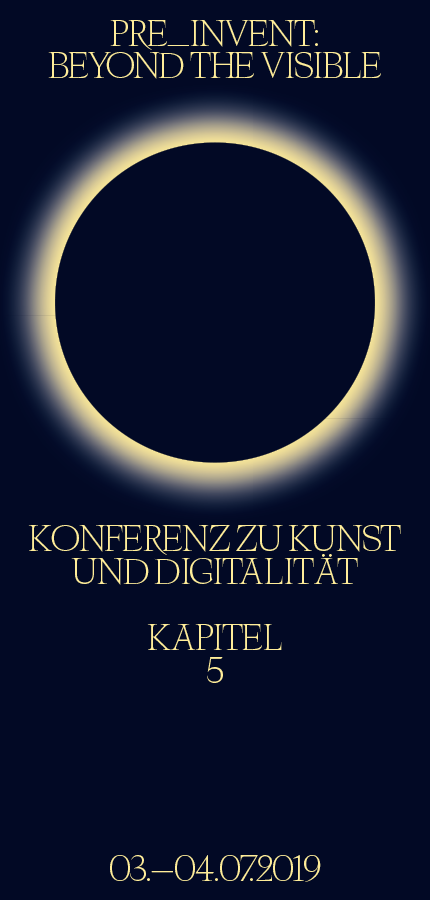PRE_INVENT V – Beyond the Visible
SYMPOSIUM
2019 | Kunstsammlung NRW | HSD – Hochschule Düsseldorf
Fred Turner, Tabor Robak, Vladan Joler, Roland Meyer, Rindon Johnson, Jakob Birken, Andreas Bunte, Angela Krewani, Mareike Foecking und Sebastian Randerath
Technologien und Anwendungen wie die automatisierte Kontrolle von Arbeit, die Vernetzung über Plattformen sowie Assistenzsysteme und Prozesse des maschinellen Lernens verändern unseren Blick auf Technologie und Gesellschaft. Auf der anderen Seite verändert sich mit ihnen aber auch der Blick der Technologien auf uns massiv. Ausgehend von aktuellen Entwicklungen aus Technologie, Gesellschaft und Kunst sollen im Rahmen der Konferenz neue Ansätze zur (Un-)Sichtbarkeit und Sichtbarmachung diskutiert werden. Dazu werden künstlerische und wissenschaftliche Positionen miteinander konfrontiert.
Technologies and applications such as the automated monitoring of work, networking on platforms and the assistance systems and processes of machine learning are altering our view of technology and society. Conversely, as this changes, so too does the view of the technologies of us – and indeed greatly. The aim of this year’s conference is to discuss new approaches to (in)visibility and visualization on the basis of the current developments in technology, society and art. To this end, artistic and scientific positions will be confronted with each other.
Pre_Invent is a conference series initiated by Prof. Mareike Foecking from the Faculty of Design at the Peter Behrens School of Arts (PBSA) – part of the University of Applied Sciences Düsseldorf (Hochschule Düsseldorf, HSD) – that has been curated in collaboration with Nina Ditscheid and Sebastian Randerath. The aim of the series of conferences is to analyze historical and current digital and political concepts as well as various design methods. On such a basis it will be possible to develop new approaches to design that will reformulate the digital as an intervention and an arena for political action.
1922 schrieb der Bauhäusler László Moholy-Nagy, dass der Mensch als solcher nie ein vollendetes Wesen sei, sondern stets durch seine visuelle Umgebung geformt werde (Vgl. Moholy-Nagy, L. 1947). Über 40 Jahre später beschloss der Mathematiker Marvin Minski, dass das Erkennen von Bildern die Grundlage für die spätere Synthese und den Lernprozess einer »künstlichen Intelligenz« bilden sollte (Vgl. Minsky, M. 1966). Gegenwärtig werden wir in den verschiedensten Kontexten mit den Konsequenzen beider Überlegungen konfrontiert.
Während die datenbasierte Steuerung von Arbeit und Anwendungen maschinellen Lernens und deren Infrastrukturen dabei meist auf die technologischen Konfigurationen ihrer Vernetzung und Automatisierung reduziert werden, wollen wir diese Technologien und Praktiken im Rahmen der Konferenz »Jenseits des Sichtbaren (Arbeitstitel)« auf der Basis des wechselseitigen Verhältnisses von Technologien und Betrachtern analysieren. Dazu werden wir, ausgehend von Kittlers Begriff der »Optischen Medien« (Vgl. Kittler, F. 1999, S.17), verschiedene Beispiele zur Verschiebung der Sichtbarkeit und ihren Grenzen der Sichtbarkeit und Sichtbarmachung von Kunst und Technologien, betrachten.
Wir werden so gemeinsam aus der Perspektive der Kunst und den Technologien, entgegen von Kittlers Überlegungen, nach dem Verhältnis von Betrachter*in und Technologien fragen. Wie werden durch die Infrastrukturen und Klassifikationssysteme zur Synthese maschinellen Lernens (Crawford, K.; Joler, V. 2018) kulturelle Verzerrungen und Vorurteile innerhalb der Systeme generiert? Welche Relation nimmt der/die Betrachter*in gegenüber datenbasierter Systeme zur Verhaltensregulierung (Vgl. Yeung, K. 2016) ein? Welchen Einfluss haben Algorithmen, Interfaces und datenbasierte Beeinflussungssysteme auf die visuelle Wahrnehmung? »Optische Medien« sind nicht länger Beobachter und Visualisierungen menschlichen Handelns, sie werden selbst zu Akteuren (Knorr-Cetina, K. 2019). Welche Position nehmen menschliche Akteure gegenüber dieser »Optischen Medien« ein? Welche emanzipatorische Strategien kann die Kunst entgegen dieser hegemonialen Technologien artikulieren (Steyerl, H. 2017) und wie wird die künstlerische Praxis selbst durch diese »Optischen Medien« geformt?
In 1922, László Moholy-Nagy, a member of the Bauhaus, wrote that dass der Mensch als solcher nie ein vollendetes Wesen sei, sondern stets durch seine visuelle Umgebung geformt werde (cf. Moholy-Nagy, L. 1947). More than 40 years later, the mathematician Marvin Minsky concluded that image recognition would provide the foundation for the subsequent synthesis and learning process for »artificial intelligence« (cf. Minsky, M. 1966). Currently, in all kinds of contexts, we are being confronted with the consequences of both these observations. Yet, the data-driven control of the work and applications of machine learning and their infrastructures are generally reduced to the technological configurations of their integration and automation.
Within the scope of the »Beyond the Visible« conference, however, we wish to analyze these technologies and practices on the basis of the mutual relationship between the technologies and observers. To this end, taking Kittler’s concept of »Optical Media« (cf. Kittler, F. 1999, p.17) as our starting point, we will consider various examples of the shifting of visibility and its boundaries and the visibility and visualization of art and technologies. Unlike Kittler’s reflections, from the perspective of art and technologies we will thus together examine the relationship between the observer and technologies.
How are cultural distortions and biases generated within these systems through the infrastructures and classification systems for the synthesis of machine learning (Crawford, K.; Joler, V. 2018)? What is the relationship that observers develop with data-based behavioral regulation systems (cf. Yeung, K. 2016)? How do algorithms, interfaces and data-based influencing systems affect visual perception? »Optical Media« are no longer observers and visualizations of human actions they themselves are becoming the actors (Knorr-Cetina, K. 2019). What position do human actors take up in relation to these »Optical Media«? What emancipatory strategies is art able to articulate against these hegemonic technologies (Steyerl, H. 2017) and how is artistic practice itself being shaped by these »Optical Media«?
